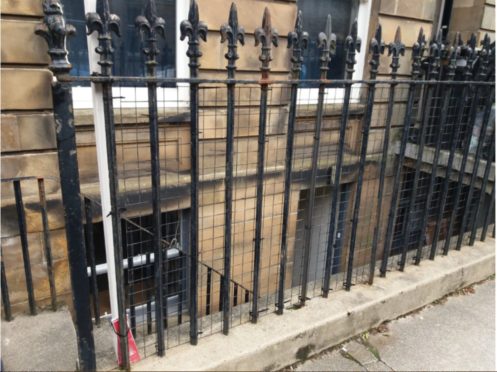Residents in St Andrews have reacted with fury to plans to use wire mesh to plug the gaps between historic railings.
The owners of a property in Hope Street are seeking listed building consent to install the mesh outside its basement flat so they can satisfy modern building regulations which say the distance between vertical cast iron railings must be no greater than 100mm.
The existing bars outside the B-listed property are currently spaced at 120mm.
The wire solution has been put forward as a compromise after the applicant’s HMO (house in multiple occupation) licence came up for renewal.
The Royal Burgh of St Andrews Community Council and the St Andrews Preservation Trust have lodged formal objections against the planning application with Fife Council.
Dorothea Morrison, planning convener of the St Andrews Preservation Trust, said the wire mesh would damage the historic street and the character of the conservation area’s character.
“HMO regulations are of great importance to ensure that every student living in an HMO property can feel relaxed in the knowledge that all the required safety measures have been met,” she said.
“These measures are generally quite sensible and it is evident why they were introduced.
“This cannot be said, however, of the suggestion that traditional railings which have been used in Scotland for well over a century with no comment on their safety have suddenly become a danger to the people who live in a property that has such railings.”
She said the trust’s planning committee was curious to know that brought about the requirement and why the measure had been deemed necessary.
“Have there been a number of accidents occurring due to the spacing being 120mm rather than 100mm; less than an inch in old money,” she asked.
“Have these accidents led to hospitalisation and what age group has been affected by accidents involving the spacing of the railings?”
She insisted the trust had no objection to the property being an HMO but said it had to object to the proposed alterations and would also seek to block any subsequent attempts to alter the railings at nearby properties.
The community council said wire mesh was “totally inappropriate” within the conservation area.
In a statement, it said: “Whilst we understand that building regulations have to be adhered to with regard to the spacing between the railings, and that the addition of horizontal or vertical bars is not desirable, it would be more appropriate to have the addition of decorative wrought iron panels, which would be more in keeping with the conservation area instead of wire mesh.”
A spokesperson for Montgomery Forgan Associates, acting on behalf of the applicant, said their client has explored a number of options to reduce the spacings while maintaining the visual integrity of the railing and concluded wire mesh would be the “least obtrusive and interventionist option”.
“The applicant has no choice other than to find a solution to the railing spacings in order that the HMO licence will be renewed,” said the spokesperson.
“It is considered that this proposal is the best solution available.”











